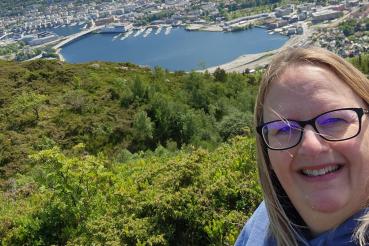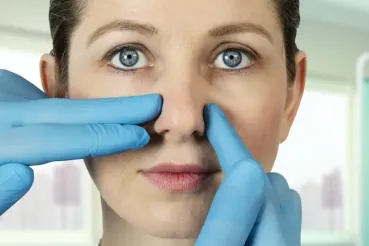Not every kid from the rural Midwest dreams of growing up to hand-rear orphaned baby chimpanzees at a primate sanctuary in the jungles of Africa. But Lindsay Maess, 39, has lived a life that most of us only read about in National Geographic.
“By the time I could talk, I was telling people that I was going to work with monkeys one day,” Lindsay says. “I would steal my brother’s monkey stuffed animals and was captivated watching primates at the Quad Cities’ Niabi Zoo.” Her fascination with primates only deepened after reading about George Schaller, Dian Fossey and Jane Goodall.
Lindsay first started to pursue her goal of working with these animals while she attended Augustana College. She volunteered at Niabi Zoo working with primates and, at age 20, she got an internship at a sanctuary in Zambia that rescues and rehabilitates chimps — and it was exactly what she’d longed for. It solidified her desire to keep following her childhood dream.
After she graduated, Lindsay worked with monkeys, chimps and gorillas at zoos and often returned to Africa for field research and to help at primate sanctuaries. But she found the perfect balance when she started doing field biology research with birds in the United States for four months a year, which allowed her to spend the rest of the year at the Pandrillus conservation organization and sanctuary for orphaned chimpanzees and endangered drill monkeys in Nigeria.
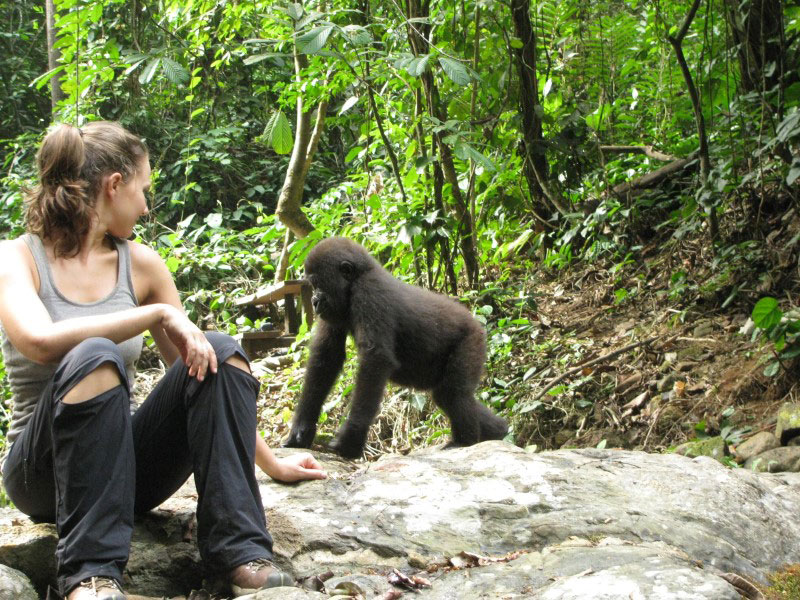
She kept up that work routine for six years and couldn’t have felt more fulfilled. “It was just what I wanted,” Lindsay says. “Every day, I felt like my whole world was complete. It was everything I loved and more. It drove me.”
But life in the jungle can pose dangers we don’t face in the Western world. When Lindsay came down with malaria, it set her on a path to severe neurological issues, pain and trauma that took so many years of her life and, if it weren’t for her team of physicians at RUSH, could have ended her dream forever.
‘I really thought I was going to die that night’
In Nigeria, malaria and other infections are part of everyday life. Over 30% of global malaria deaths happen in Nigeria. And while Lindsay took measures to protect herself, the region and the nature of her work put her at constant, unavoidable risk.
“Getting malaria and typhoid and dengue fever, it was kind of part of the job. I don’t want to say I became nonchalant about it, but for all of us, it was like, ‘OK, well you’ve got malaria. You take the meds, and it’s a really bad week, you feel like death, but you rest up and you get better,’” Lindsay says. “Until one day, it didn’t go that way.”
In April of 2016, Lindsay tested positive for a parasitic infection — Plasmodium falciparum.
“There are five different species of malaria that can infect humans, Plasmodium falciparum being the most dangerous because it can cause cerebral malaria and potentially death,” Lindsay says.
She took two rounds of drug treatments, but after a few weeks, she was still feeling very sick. Her blood was tested again and showed that she not only still had malaria, but also a paratyphoid B infection, known to cause a high fever and severe illness.
The day after she began her third round of medication, Lindsay developed the worst headache of her life. The next few days brought shooting pain through her whole head, fever and bleeding sores all over her face. She felt like electricity was running through her tongue, lips, face and ears.
The pain spread to her shoulders, spine and left arm. She felt dizzy and confused, like she was intoxicated.
On the night of May 10, 2016, she could barely stand up, and the left side of her face and body became paralyzed. Her heart rate dropped, and she could hardly swallow or speak. Lindsay called her partner back in the U.S. just to try to stay awake and make it through the night.
“I was terrified to even fall asleep because I didn’t think I would wake up. I really thought I was going to die that night,” Lindsay says. “I remember sitting on my bed hunkered in a ball, trying to fight the vertigo, then lying on my back, holding on for dear life because it felt like I was on a Tilt-A-Whirl. My veins felt like they were going to explode.”
A medical mystery
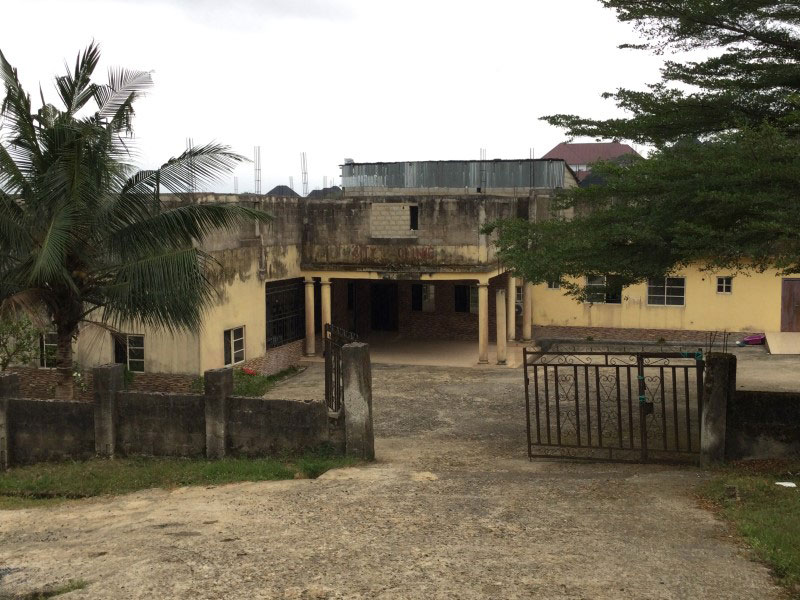
The next day, she was rushed to a doctor in Nigeria. He believed he had seen Lindsay’s symptoms before and said it was likely the result of taking the malaria drug.
The medication can cause intense side effects, so the diagnosis made some sense. Lindsay also notes that up to 30% of the medications in Nigeria are substandard or counterfeit. If she had taken counterfeit drugs, they might cause severe symptoms as well.
The doctor treated Lindsay with intravenous steroids and recommended bed rest, saying that the drug simply needed time to get out of her system.
But rather than getting better, Lindsay’s symptoms became more concerning. Her head, left arm and leg began contracting uncontrollably.
“I remember losing the ability to swallow. I was drooling,” Lindsay says. “It’s the most terrifying thing to not be able to function. It was a complete nightmare, and I was in excruciating pain — pain that I never even thought could exist. And the extreme migraine hadn’t gone away since the onset.”
She knew her best chance at finding the treatment she needed was to get back to the U.S. At the time, West Africa was in the midst of the Ebola crisis, so screenings and restrictions made travel difficult. It would take a month of bed rest before she could even get on a plane. When she finally managed to return, her local physician referred her to a neurologist in Peoria.
“The neurologist there told me, ‘I’m one of the best at what I do, and whatever is going on with you neurologically, I don’t know what to do,’” Lindsay says. “I appreciate him being honest.”
The neurologist referred Lindsay to University of California San Francisco, but insurance issues prevented her from continuing her care there. So a UCSF doctor said he could refer her to the Mayo Clinic or RUSH.
Lindsay chose RUSH. “And I’m so glad I did,” Lindsay says. “I can’t imagine this journey being anywhere else.”
A community of care
By the time Lindsay came to RUSH in January of 2019, her life had completely changed. She could barely swallow, talk or be social anymore — much less continue her life’s work with primates.
“To get through those years before coming to RUSH, I didn’t want to live through it,” Lindsay says. “The pain and vertigo were so intense, and I thought there was no way I could keep going like this.”
At RUSH, she would finally get relief, not only from one doctor, but from a community of physicians that worked together to address all her medical concerns.
Underlying neurological problems, malaria medication and the infections Lindsay had can all lead to symptoms that she was experiencing. It would be hard to find one single root cause of all her medical issues, so physicians at RUSH treated each of her symptoms one by one.
The first person she saw was a RUSH neurotologist who immediately recognized the complexity of Lindsay’s case. The neurotologist referred Lindsay to physical therapy while running tests in consultation with the Division of Infectious Diseases to better understand her symptoms.
The neurotologist also referred Lindsay to Ryan Smith, MD, a facial plastic surgeon at RUSH who specializes in treating facial nerve disorders. Assuring he would do whatever it took to help, he worked to tailor her treatment.
“We evaluate the effectiveness of the last treatment a lot and modify it to get a better outcome for the next one every single time, and I think that's allowed us to really fine tune our approach,” Smith says.
Smith gave Lindsay Botox injections. “A lot of people know Botox from its cosmetic use of eliminating wrinkles, of course,” Smith says. “But the truth is it has a ton of well-established medical uses — for facial paralysis, involuntary face muscle contractions, all these issues that Lindsay had.”
Lindsay also worked with Sandeep Amin, MD, a pain management physician at RUSH, to further treat her nerve pain and migraine. “Her nervous system was in hyper-drive mode when I first saw her, accounting for her facial issues, pain, headaches and difficulty swallowing,” Amin says.
To treat these issues, he used ultrasound imaging as a guide to place several nerve blocks, injecting anesthesia into specific nerves in Lindsay’s head and neck. “It’s almost like resetting the neurologic system and bringing it into normal drive mode,” Amin says.
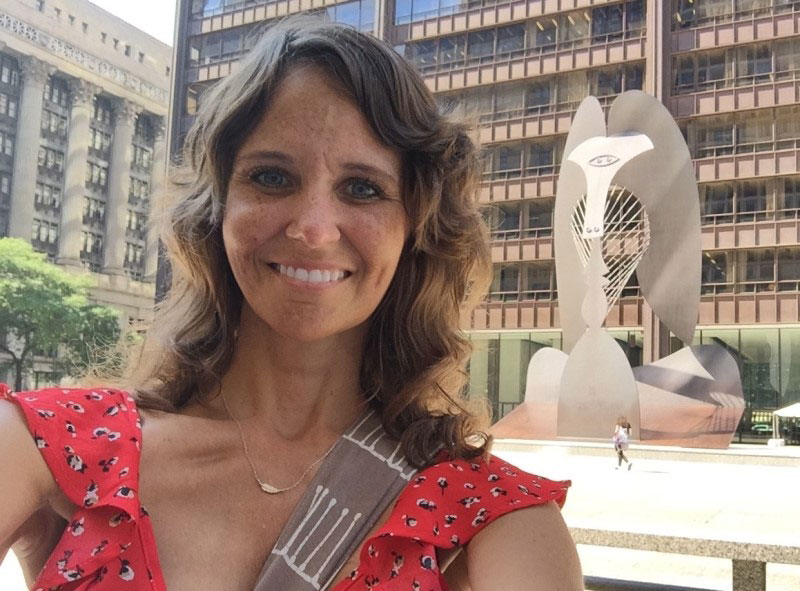
With her new treatments, Lindsay was able to smile and talk again without pain or facial spasms. She could think more clearly with the vertigo under control. And while these treatments were effective, Lindsay credits Smith and Amin for more than just injections and nerve blocks.
“Dr. Smith and Amin, what’s so special about them is that they’ll sit and listen,” Lindsay says. “They’ve been so patient and persistent with me. Dr. Smith has probably missed lunch hours just from answering my many questions and letting me express everything I wanted to say. And Dr. Amin has been relentless at peeling back and treating the layers of my pain with compassion.”
However, managing physical conditions is only one part of healing. When Lindsay’s symptoms start to return, she finds herself reliving the despair of her terrifying month in Nigeria and all the pain and hardship that followed.
As part of her ongoing care, Lindsay worked closely with RUSH psychologist Susan Buehler, PhD.
“Lindsay felt lost when her dream life working with chimps, gorillas and drill monkeys in Africa was put on hold,” says Buehler. “She sought therapy to learn skills to cope with her symptoms, but also to find new ways to build a meaningful life throughout her recovery.”
“Dr. Buehler taught me to work through my symptoms and accept what happened,” Lindsay says. “She guided me through my progress and helped me rebuild a life with new boundaries and limits while pacing myself. She empowered me to take my life back. I can’t imagine working through this with anyone else.”
Under the care of many physicians at RUSH, Lindsay gradually improved, both physically and emotionally. She still returns to RUSH every few months for treatment. But with her symptoms under control, she once again plans to return to Africa and continue her work with primates.
“The whole time I thought I was losing my career, but I knew I wasn’t,” Lindsay says. “I knew it would be there when I went back — if I could go back. People in my life have been so supportive of me and know it’s been my passion since I was 4 years old. Every decision I made in my life was to go and do the work I did, and it’s still what drives me.”
But most of all, it is her hope that what she went through will one day help someone else in need. “In sharing my story and the aftermath of dealing with these infections, my hope is that it changes even one person’s life — to let them know there are treatments even when none seem to exist,” Lindsay says. “That’s all I could ask for.”
Find out more about Pandrillus, the organization Lindsay works with in Nigeria. You can also learn more about the Malaria Initiative that Lindsay will collaborate with when she returns to Africa.
If you need evaluation and treatment for a facial nerve disorder, call RUSH at (888) 352-7874.


